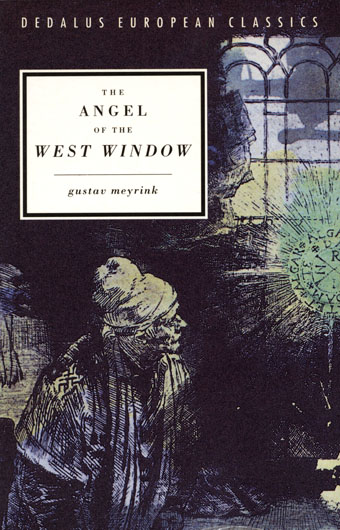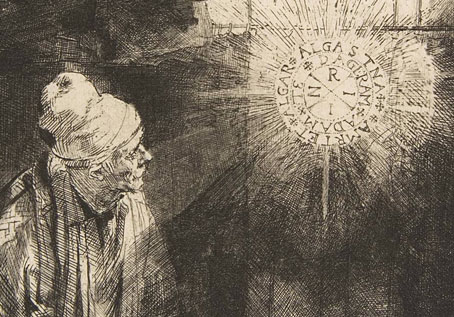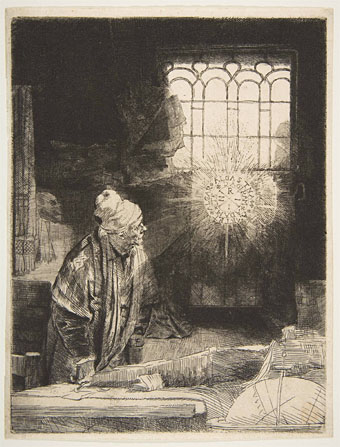A Scholar in his Study (detail, 1650–1654) by Rembrandt van Rijn.
Rembrandt produced many etchings throughout his long career, and if he hadn’t also distinguished himself as a painter his etchings alone would have ensured that his reputation survived. For an example of his mastery of deep shadow see St. Jerome in a Dark Chamber (1642) where the solid masses of shade are created by a virtuoso display of cross-hatching.
One etching is reproduced far more often than any of the others, the piece known as A Scholar in his Study, which can also be found labelled The Magician, or simply Faust even though it was never intended as an illustration of anyone so specific. The etching is often used as an illustration for Goethe’s play, of course, understandably when it’s one of the few instances in Western art of a first-rate artist depicting a visible occult event. Prior to the 19th century the depiction of magic in paintings or graphic works was generally limited to either mythological or religious tableaux, or to scenes of generic witchery. Rembrandt’s piece is unusual in showing what appears to be a manifestation of some sort, with a disc of Divine Names either partly concealing or forming the head of a spectral figure. The figure is barely visible in smaller reproductions but this large copy reveals the pair of hands below the disc which are drawing the scholar’s attention to what might be a mirror reflecting the glowing disc. Rembrandt produced a number of paintings and etchings on the theme of the scholar or philosopher in his study but none are as curious—or as popular—as this example. If it wasn’t for over-familiarity it’s likely it would seem even stranger today.

The Angel of the West Window (1991). Design by Tim Gray.
Elsewhere on { feuilleton }
• The etching and engraving archive
Previously on { feuilleton }
• Rembrandt’s vision



Neat. I have a few books with “A Scholar in his Study” used on the cover and had never noticed that there was a figure connected to the disk. The only one I can think of off the top of my head is the Dover edition of “The Book of the Sacred Magic of Abra Melin.” The obvious allusion to Qabalistic magic has always tickled me.
I like it’s use on the older cover to “The Angel of the West Window” as well. I’d never seen it before: I have one of the newer editions with Dee and the Sigillum Dei on the cover.
Like G. I had never noticed the pointing hand, and I have even seen the print up close! Aside from the central INRI has anyone deciphered the rest of it?
Every time I look at that seal I think I’ve seen it before but I’ve yet to find it anywhere. It’s familiar because it’s superficially like many other seals such as those in the Key of Solomon but it doesn’t match any of those.
http://www.esotericarchives.com/solomon/ksol.htm